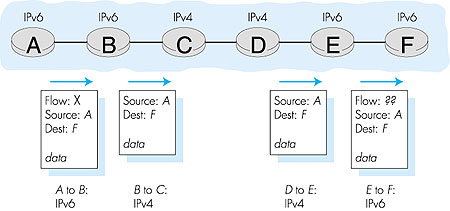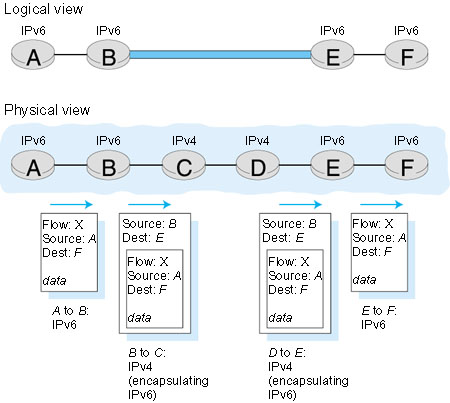4.7: IPv6
| In the early
1990s, the Internet Engineering Task Force began an effort to develop a
successor to the IPv4 protocol. A prime motivation for this effort was
the realization that the 32-bit IP address space was beginning to be used
up, with new networks and IP nodes being attached to the Internet (and
being allocated unique IP addresses) at a breathtaking rate. To respond
to this need for a large IP address space, a new IP protocol, IPv6, was
developed. The designers of IPv6 also took this opportunity to tweak and
augment other aspects of IPv4, based on the accumulated operational experience
with IPv4.
The point in time when IPv4 addresses would have been completely allocated (and hence no new networks could have attached to the Internet) was the subject of considerable debate. Based on current trends in address allocation at the time, the estimates of the two leaders of the IETF's Address Lifetime Expectations working group were that addresses would become exhausted in 2008 and 2018, respectively [Solensky 1996]. In 1996, the American Registry for Internet Numbers (ARIN) reported that all of the IPv4 class A addresses had been assigned, 62 percent of the class B addresses had been assigned, and 37 percent of the class C addresses had been assigned [ARIN 1996]. Although these estimates and numbers suggested that a considerable amount of time might be left until the IPv4 address space became exhausted, it was realized that considerable time would be needed to deploy a new technology on such an extensive scale, and so the "Next Generation IP" (IPng) effort [Bradner 1996; RFC 1752], was begun. An excellent online source of information about IPv6 is The IP Next Generation Homepage [Hinden 1999]. An excellent book is also available on the subject [Huitema 1997]. 4.7.1: IPv6 Packet FormatThe format of the IPv6 packet is shown in Figure 4.40. The most important changes introduced in IPv6 are evident in the packet format:
Recall from our discussion in Section 4.4, that the ICMP protocol is used by IP nodes to report error conditions and provide limited information (for example, the echo reply to a ping message) to an end system. A new version of ICMP has been defined for IPv6 in RFC 2463. In addition to reorganizing the existing ICMP type and code definitions, ICMPv6 also added new types and codes required by the new IPv6 functionality. These include the "Packet Too Big" type, and an "unrecognized IPv6 options" error code. In addition, ICMPv6 subsumes the functionality of the Internet Group Management Protocol (IGMP) that we will study in Section 4.8. IGMP, which is used to manage a host's joining and leaving of so-called multicast groups, was previously a separate protocol from ICMP in IPv4. 4.7.2: Transitioning from IPv4 to IPv6Now that we have seen the technical details of IPv6, let us consider a very practical matter: how will the public Internet, which is based on IPv4, be transitioned to IPv6? The problem is that while new IPv6-capable systems can be made "backwards compatible," that is, can send, route, and receive IPv4 datagrams, already deployed IPv4-capable systems are not capable of handling IPv6 datagrams. Several options are possible.One option would be to declare a "flag day"--a given time and date when all Internet machines would be turned off and upgraded from IPv4 to IPv6. The last major technology transition (from using NCP to using TCP for reliable transport service) occurred almost 20 years ago. Even back then [RFC 801], when the Internet was tiny and still being administered by a small number of "wizards," it was realized that such a flag day was not possible. A flag day involving hundreds of millions of machines and millions of network administrators and users is even more unthinkable today. RFC 1933 describes two approaches (which can be used either alone or together) for gradually integrating IPv6 hosts and routers into an IPv4 world (with the long-term goal, of course, of having all IPv4 nodes eventually transition to IPv6). Probably the most straightforward way to introduce IPv6-capable nodes is a dual-stack approach, where IPv6 nodes also have a complete IPv4 implementation as well. Such a node, referred to as an IPv6/IPv4 node in RFC 1933, has the ability to send and receive both IPv4 and IPv6 datagrams. When interoperating with an IPv4 node, an IPv6/IPv4 node can use IPv4 datagrams; when interoperating with an IPv6 node, it can speak IPv6. IPv6/IPv4 nodes must have both IPv6 and IPv4 addresses. They must furthermore be able to determine whether another node is IPv6-capable or IPv4-only. This problem can be solved using the DNS (see Chapter 2), which can return an IPv6 address if the node name being resolved is IPv6-capable, or otherwise return an IPv4 address. Of course, if the node issuing the DNS request is only IPv4-capable, the DNS returns only an IPv4 address. In the dual-stack approach, if either the sender or the receiver is only IPv4-capable, an IPv4 datagram must be used. As a result, it is possible that two IPv6-capable nodes can end up, in essence, sending IPv4 datagrams to each other. This is illustrated in Figure 4.41. Suppose node A is IPv6 capable and wants to send an IP datagram to node F, which is also IPv6-capable. Nodes A and B can exchange an IPv6 packet. However, node B must create an IPv4 datagram to send to C. Certainly, the data field of the IPv6 packet can be copied into the data field of the IPv4 datagram and appropriate address mapping can be done. However, in performing the conversion from IPv6 to IPv4, there will be IPv6-specific fields in the IPv6 datagram (for example, the flow identifier field) that have no counterpart in IPv4. The information in these fields will be lost. Thus, even though E and F can exchange IPv6 datagrams, the arriving IPv4 datagrams at E from D do not contain all of the fields that were in the original IPv6 datagram sent from A.
An alternative to the dual-stack approach, also discussed in RFC 1933, is known as tunneling. Tunneling can solve the problem noted above, allowing, for example, E to receive the IPv6 datagram originated by A. The basic idea behind tunneling is the following. Suppose two IPv6 nodes (for example, B and E in Figure 4.41) want to interoperate using IPv6 datagrams, but are connected to each other by intervening IPv4 routers. We refer to the intervening set of IPv4 routers between two IPv6 routers as a tunnel, as illustrated in Figure 4.42. With tunneling, the IPv6 node on the sending side of the tunnel (for example, B) takes the entire IPv6 datagram and puts it in the data (payload) field of an IPv4 datagram. This IPv4 datagram is then addressed to the IPv6 node on the receiving side of the tunnel (for example, E) and sent to the first node in the tunnel (for example, C). The intervening IPv4 routers in the tunnel route this IPv4 datagram among themselves, just as they would any other datagram, blissfully unaware that the IPv4 datagram itself contains a complete IPv6 datagram. The IPv6 node on the receiving side of the tunnel eventually receives the IPv4 datagram (it is the destination of the IPv4 datagram!), determines that the IPv4 datagram contains an IPv6 datagram, extracts the IPv6 datagram, and then routes the IPv6 datagram exactly as it would if it had received the IPv6 datagram from a directly connected IPv6 neighbor.
We end this section by mentioning that there is currently some doubt about whether IPv6 will make significant inroads into the Internet in the near future (2000-2002) or even ever at all [Garber 1999]. Indeed, at the time of this writing, a number of North American ISPs have said they don't plan to buy IPv6-enabled networking equipment. These ISPs say that there is little customer demand for IPv6's capabilities when IPv4, with some patches (such as CIDR, see Section 4.4.1, and network address translator [RFC 1631] boxes), is working well enough. On the other hand, there appears to be more interest in IPv6 in Europe and Asia. One important lesson that we can learn from the IPv6 experience is that it is enormously difficult to change network-layer protocols. Since the early 1990s, numerous new network-layer protocols have been trumpeted as the next major revolution for the Internet, but most of these protocols have had limited penetration to date. These protocols include IPv6, multicast protocols (Section 4.8), and resource reservation protocols (Section 6.9). Indeed, introducing new protocols into the network layer is like replacing the foundation of a house--it is difficult to do without tearing the whole house down or at least temporarily relocated the house's residents. On the other hand, the Internet has witnessed rapid deployment of new protocols at the application layer. The classic example, of course, is HTTP and the Web; other examples include audio and video streaming and chat. Introducing new application layer protocols is like adding a new layer of paint to a house--it is relatively easy to do, and if you choose an attractive color, others in the neighborhood will copy you. In summary, in the future we can expect to see changes in the Internet's network layer, but these changes will likely occur on a time scale that is much slower than the changes that will occur at the application layer. |


